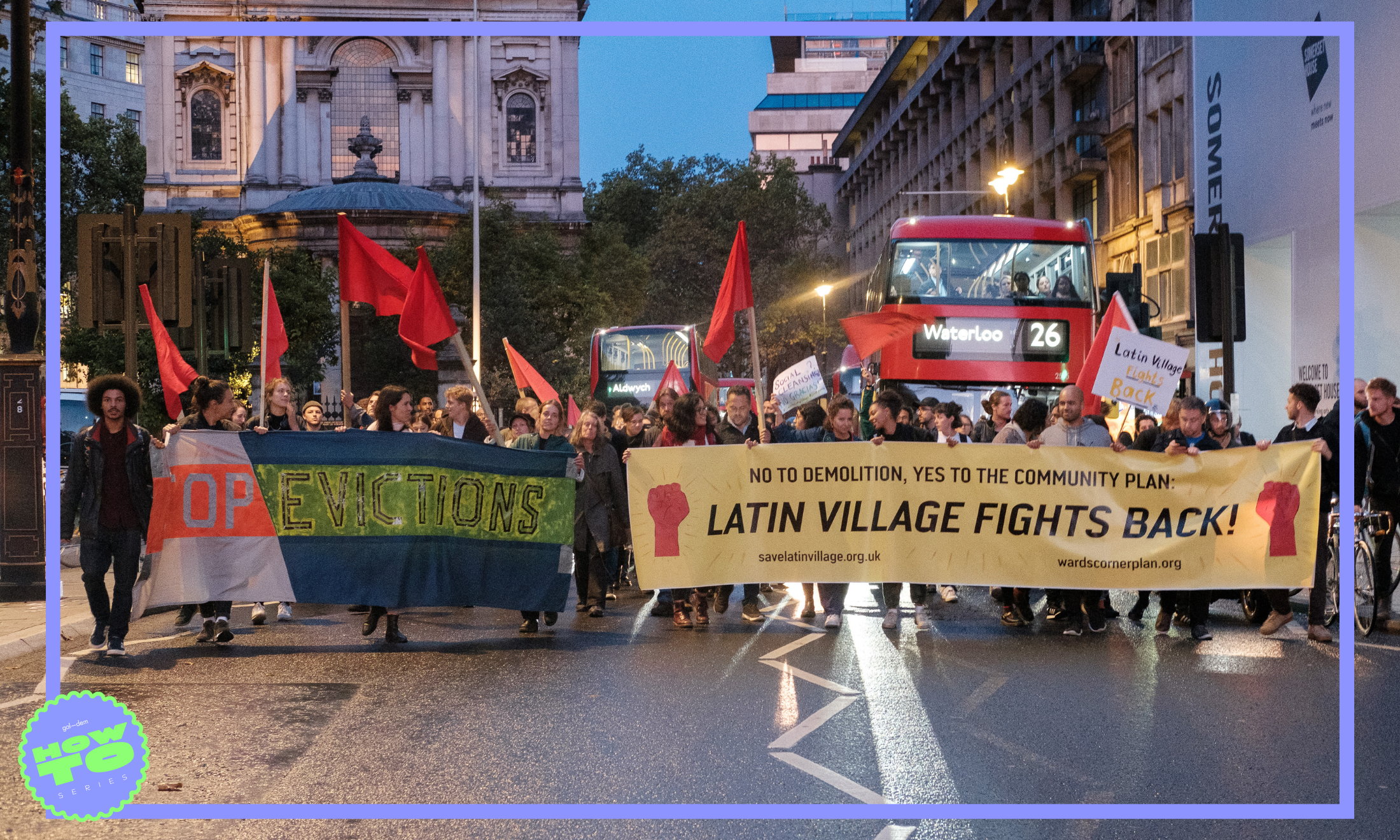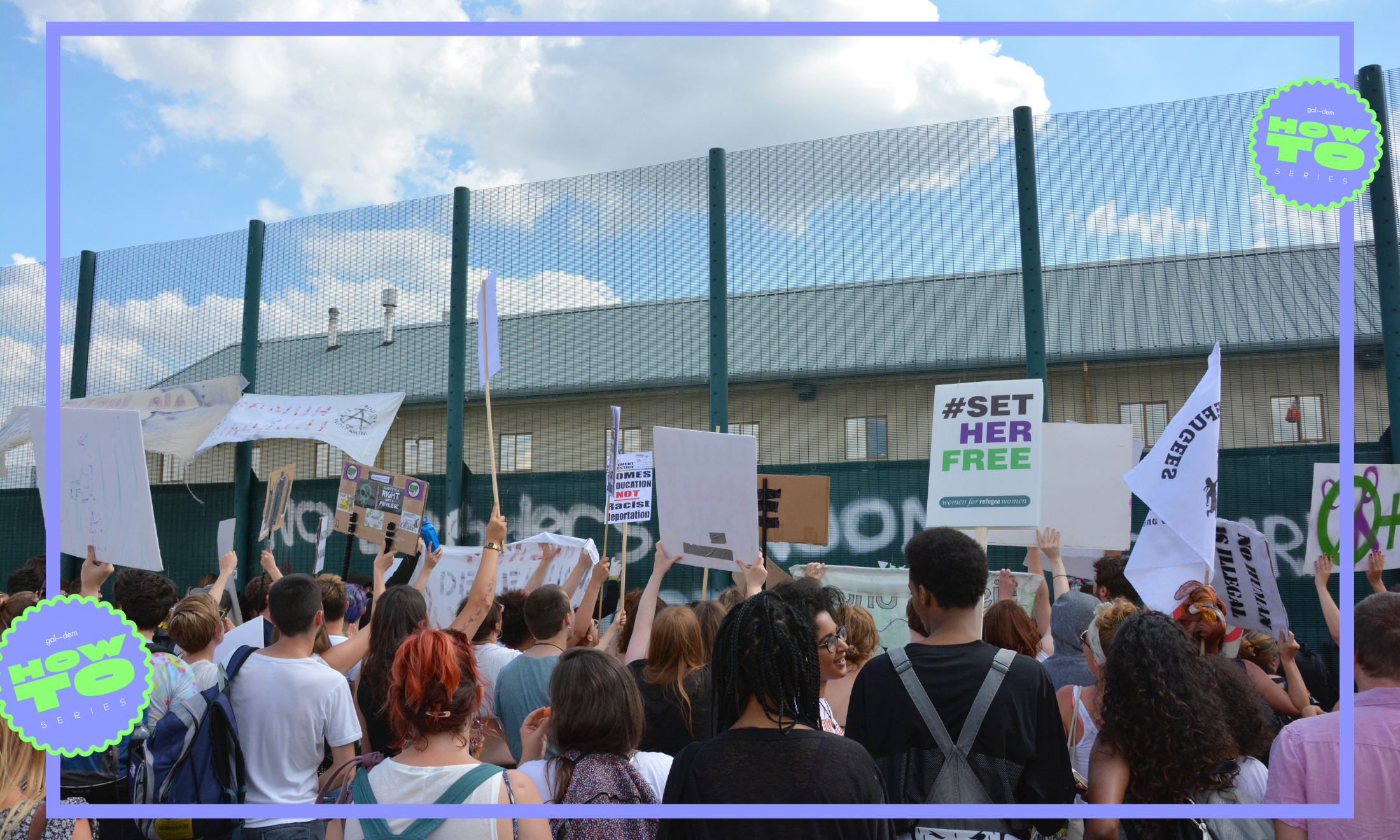The gal-dem guide to resisting property developers
How To is a gal-dem series dedicated to demystifying practical steps involved in community activism.
Lisa Insansa
01 Feb 2022

Mario Washington-Ihieme
Where do I begin?
Property development is often at the expense of low income and migrant communities. And when it comes to engaging in the David-and-Goliath-esque battle against such a threat often there isn’t a clear-cut “beginning”. Instead, you will be joining a long line of campaigns and organisers who have been resisting gentrification since the first rumbles of a displaced fate were felt.
“It’s really important to realise that a lot of these campaigns are building upon the work of other people,” says Javie Huxley, a member of London’s Save Latin Village campaign. “Instead of going into a campaign planning exactly what to do and how to do it, you should be open to learning from the people around you,” Javie continues.
The SLV campaign is a 15-year strong battle against big developers looking to “regenerate,” aka destroy, the Latinx market located in Seven Sisters, within north London’s Tottenham district. The market hosts a variety of small businesses run by Latin American migrant communities. Its sanctity as an important cultural hub, hailed even by the United Nations, has been under threat for the last two decades at the hands of multi millionaire developer Grainger, who had a plan to demolish the market and nearby Wards Corner building to build unaffordable homes that would displace local traders and disfigure the cultural, as well as economic, landscape.
This is not a lone story. In September of 2020 the local community mourned the closure of Elephant and Castle’s Latinx market, following an arduous campaign by Latin Elephant, as bulldozers tore down yet another space of cultural significance.
Choosing to fight against a property developer is a matter of people’s income, livelihoods and security being destroyed. Therefore, when you’re starting out, it’s important to interrogate the reasons for joining a campaign and what your personal connection is to it, especially in a time where “activism” has sometimes become a way to extract cultural capital from its radical roots. “With reference to our campaign,” says Javie, “it wasn’t a case of starting a fight 15 years ago, it was a case of necessity.
“It was either we come together as a community against developers or we get pushed out of our home.”
What do I need to know?
If challenging property development, it’s necessary to seek out information regarding planning applications, council schemes and about the developer itself, so that you know your enemy and are aware of their plans. Becoming familiar with the nuts and bolts of the project allows campaigners to find potential weaknesses (such as the failure to follow correct processes in a planning application). This can help buy crucial time to further resist or throw up such an obstacle that the scheme has to be stopped altogether.
Doing so can entail finding relevant details about those involved, such as the names of property developers, construction companies and security companies, as well as businesses which will benefit at the cost of the community (for example, chain businesses that will replace local sellers and exploit workers for profits). On top of this, there will be councillors and politicians who support the development, so it can be handy to find out why and what incitement might have been involved to win their backing.
“Becoming familiar with the nuts and bolts of the project allows campaigners to find potential weaknesses”
Once you do know your enemy, you can find out more about their plans. This can be done by reading through planning applications which can usually be found online through a quick Google search or through your local council website, as the council needs to sign off on the plan. One website that can aid in this search is Planning Finder. You can also attend local council meetings and/or read their minutes which can be requested from council websites too.
Elara, who’s working as part of the N15 Development Trust, explains that: “although information about the development can usually be found online, these websites are usually difficult to navigate and they each use a different format which can be a nightmare.”
To make sense of them, get in touch with long-term community organisers, councillors who oppose the development and the local community itself who can share knowledge on how to navigate. As well as building up necessary relationships to work together, this will allow you to know the history of resistance in the community so that you’re not making the same mistakes: talk to the elders!
Do I need to understand property jargon?
“When you’re dealing with bureaucratised and deliberately confusing systems, I don’t think it’s a case of everyone in the campaign knowing how to navigate and understand the information,” says Elara. “There will be others who can do it. But it can be helpful to learn and you will just naturally pick up things.”
Adding to this, Kieran Kirkwood, who is involved in both Save Latin Village and Save Ridley Road – a campaign to protect a historic East London neighbourhood from destruction that recently won a huge victory – says: “It’s good to be able to decode the language of the power holders, but to be honest, if you’re in the local area and are plugged into what the locals are thinking, you would already know what’s going on.
“With Ridley Road, there’s this one solicitor who lives round the corner from the market and he loves the market so we’ve developed a trust,” they add.
Where do I go to start understanding property legalese?
You can seek out experts such as solicitors, who as Kieran found, can come from the local community and are intimately connected to the campaign. As well as solicitors who have a speciality in property law, helpful advice is usually provided via talking to other anti-gentrification organisers who are likely to have contacts. For example, in addition to Save Latin Village, a few London campaigns in recent years include: Fight The Tower, Up The Elephant and Save Brick Lane. Additionally, tenant unions can often provide general advice. Acorn is nationwide but you can do a quick internet search to locate a union local to your area. These groups may also be able to offer material support – especially via direct action.
What are the tactics to use?
“Protests have been an integral part of our campaign, especially before the pandemic,” says Javie. “Another really important tactic is community building, whether that be through fundraisers or events, as we need to centre the reasons why we are all here.”
When organising, persistence is key, as well as diversity of tactics and escalation. To put this into practice, you can organise with the impacted community through petitions, letters to relevant politicians and surveys, as well as through political and social events including meetings, assemblies, music events, film screenings, panels and demonstrations. Momentum can be maintained by engaging in these regular actions and noting important dates – for example, key council meetings – as horizons to aim for and points of escalation. The militant feeling of resistance can be expressed clearly to councillors and developers via blockades and occupations of council offices and meetings as well as the offices of developers themselves or, alternatively, public events i.e is the construction company doing a recruiting day?
Ultimately, if the council has to sign it off, you can stop the development by convincing councillors it is not in their interests to do so (Does the council have a small majority? Is the affected community big enough to influence that? Could particular councillors be swayed through aggressive lobbying?). If the developer feels it will meet militant resistance that will make the project fiscally non-viable then they may perhaps terminate it.
The Save Latin Village campaign is a great example of successful resistance. In August 2021, Grainger, the property developer attempting to uproot the market, finally withdrew after a long fight by campaigners. Now the campaign is looking to implement a new community plan which rethinks the typically destructive nature of urban regeneration on long-standing migrant communities and instead proposes a grassroots structure centring the Latinx community. This aspect is vital, says campaigners. “It’s not just about fighting against something, you need to be offering an alternative,” says Elara.
How can public support be raised?
“Social media has been a really amazing way for us to raise awareness,” says Javie, “especially when fundraising and when keeping people updated.
“Within that [though] there should be an awareness of the technological gap which can alienate certain communities, especially across different generations.”
“One of the strongest things you can do is to be visible and communicate with the local community so that you have a base of local people who know what’s happening,” Kieran adds. They also believe in “solidarity and cross-pollination with other campaigns with similar missions”. The struggle against gentrification is not an isolated instance, and each individual campaign is part of the overall struggle against capitalist ideas of tearing up communities for profit.
Communicating with the local community can translate into door-knocking around local residences, or visiting local businesses, community and cultural spaces. These spaces can also be used to organise and promote events.
Another thing to note when thinking of public support is making sure that you’re not taking the support you already have for granted. “There’s no guarantee that it will be there the next day,” says Elara, “so we need to focus on regularity and consistency.”
What resistance should be expected from property developers?
Property developers can often pull sneaky tricks as their goal is to fulfil their plans which ultimately means squashing any action against it. For example, in January 2020, the Save Latin Village campaign was met with hostility as bailiffs tried to forcefully evict traders after Haringey Council rejected any preservation of the space and Jonathan Owen – who held the conflicting duties of both protecting and evicting traders – decided to throw the Latinx community under the bus. Organisers and the local community went to occupy the site and protest against the eviction with success.
In order to prepare for these situations, you can take practical steps such as setting up group chats or broadcast lists to get people down to support in sudden attacks from the developer, as well as using social media.
What can make a campaign against property development?
“The socialising aspect is really important and often overlooked,” says Javie, “like having a meal or going for a pint together.
“One thing that’s really beautiful about our campaign is that feeling of family where people actually care for each other. Why would anyone fight for something that they don’t feel a part of?”
It is necessary to be thinking about capacity when engaging in these campaigns. “I know it sounds really corny,” says Kieran, “but many hands make light work. We need to be creating a sustainable framework, which could literally be about building mass participation, or making clear roles because otherwise you’ll have one or two people doing everything.“
Elara believes that you need to be prepared to lose small battles along the way. “It’s really easy in that long process when there’s not that high energy to let low periods where nothing feels like it’s happening to want to quit,” she says. “However the fight can be long and individual losses should be treated as learning points.”
What can break a campaign against property development?
“Burnout,” say all three campaigners. Javie discusses the breakdown that she had following their occupation of Latin Village to resist eviction in September. “Me and Kieran stepped in at the last minute out of necessity but it was quite a traumatic experience which left me feeling depleted,” she says. ”The campaign can be so emotionally taxing, especially when you’re unprepared and take on too much.” Javie explains that she had to take a step back for a while to focus on rest.
“There is a difference between active rest and passive rest,” says Kieran. “Passive rest is when my body just shuts down because it’s been pushed too far, and active rest is choosing to rest to prevent burnout.” The group all believe in the importance of setting healthy boundaries when doing campaign work. “You need collective care and healing to keep the energy up,” says Elara.
What else should I remember?
The struggle of communities opposing gentrification is defined by deep asymmetries of power. The developers will have more and often better legal representation, they will have lobbied for, and attained, the necessary political backing and – fundamentally – they exist within a legal and institutional framework which is geared towards the protection of property owners and the extraction of profit. As a result, successful campaigns against the continuation of the colonial logic of displacement and occupation demand the militant and active refusal of a community to submit. Therefore, it is our job to take a stand and make exploitative property development a social, political and material impossibility.








